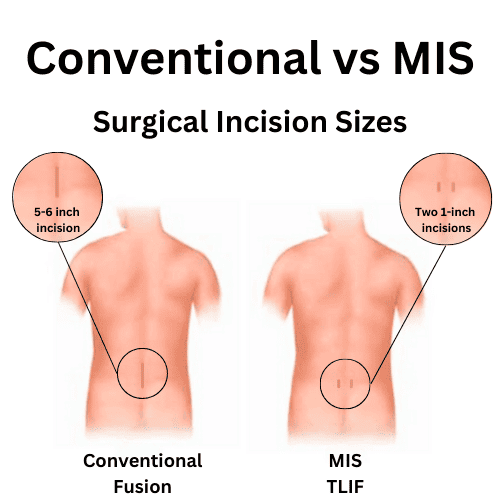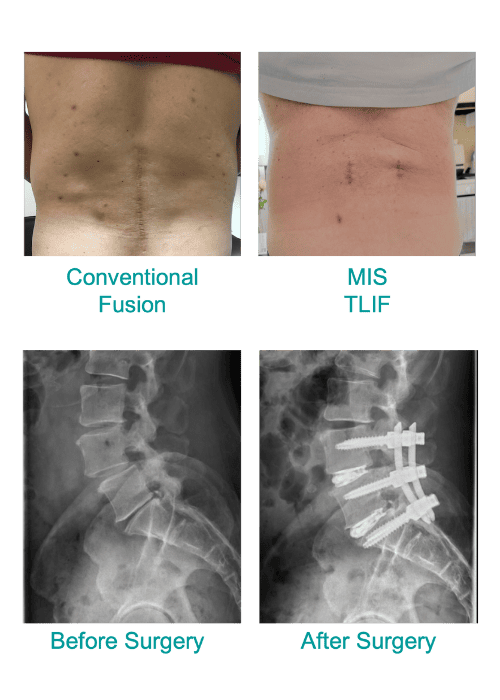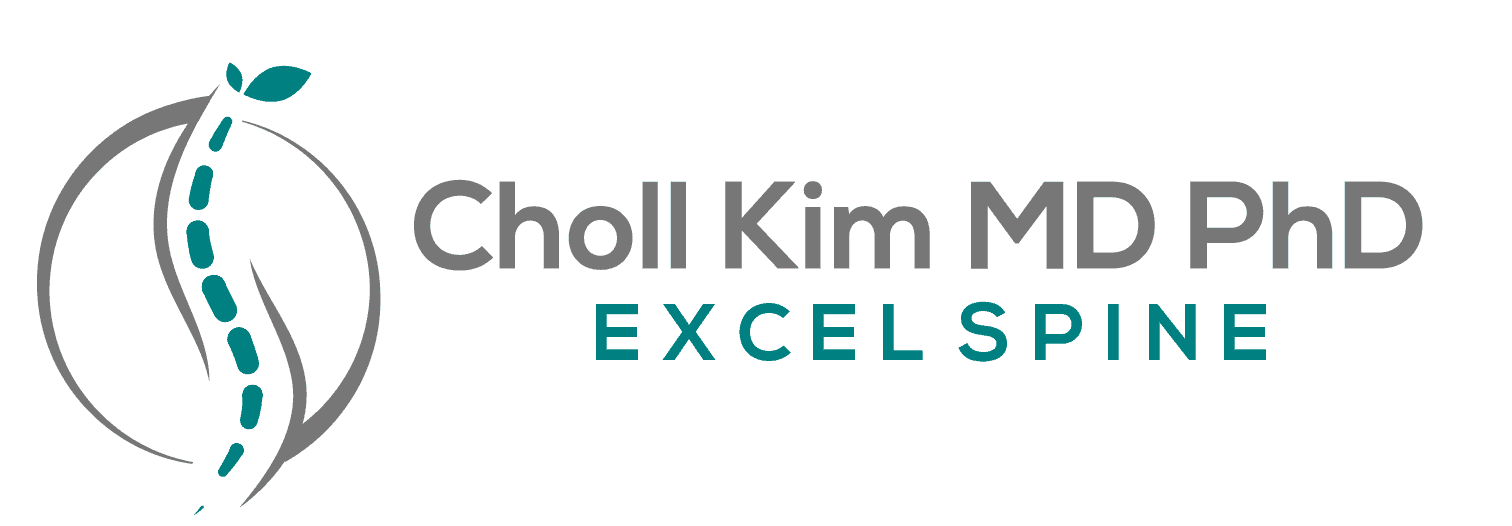What is MIS TLIF?
How is a minimally invasive lumbar fusion different from a conventional fusion?
The goal of a fusion is to re-align the spine and fuse the vertebrae into one solid piece of bone to eliminate abnormal motion that causes pain. Conventional open lumbar fusions are performed through a midline incision that detaches important stabilizing muscles around the spine. Minimally invasive lumbar fusions are performed through two 1-inch incisions on either side of the spine by gently separating the muscles surrounding the spine, rather than cutting through them. These small incisions minimize structural damage to bones and muscles such as the multifidus, which is important for spine stability. Less structural damage leads to more rapid recovery and faster return to activities after spinal fusion surgery.
Surgery
Dr. Kim will use the latest, state of the art minimally invasive instruments to realign your spine. Neuromonitoring will be used to assess the nerves and computer navigation will allow Dr. Kim to know where everything is in 3-dimensional space throughout the surgery. Dr. Kim is in contact with patient’s family members during and after surgery. Patients stay overnight in a private room and go home the next day.
How Is a Minimally Invasive Lumbar Fusion Different From a Conventional Fusion?
Traditional open lumbar fusion surgeries involve a larger midline incision and require cutting through the muscles and soft tissues surrounding the spine. This approach can lead to greater muscle damage, more blood loss, increased postoperative pain, and a longer recovery time.
In contrast, MIS TLIF is performed through two small incisions—typically about 1 inch long—on either side of the spine. Using specialized instruments and real-time imaging guidance, the surgeon gently separates the muscles rather than cutting through them. This approach helps preserve important stabilizing muscles like the multifidus, which plays a key role in spinal support and balance.
As a result, patients undergoing MIS TLIF typically experience:
- Less postoperative pain
- Less blood loss
- Reduced muscle damage
- Shorter hospital stays
- Faster recovery and return to daily activities


Why Is MIS TLIF Performed?
MIS TLIF is typically performed to relieve symptoms caused by spinal conditions that have not responded to non-surgical treatments like physical therapy, injections, or medication. These conditions may include:
- Degenerative disc disease
- Spondylolisthesis
- Spinal stenosis
- Recurrent disc problems
- Spinal instability or deformity
Patients may experience symptoms such as lower back pain, radiating leg pain (sciatica), numbness, tingling, or muscle weakness. By stabilizing the affected segment and relieving pressure on the nerves, MIS TLIF can significantly improve quality of life.
How Do You Prepare for MIS TLIF?
Before surgery, you will undergo a full evaluation including imaging studies (MRI, X-rays, or CT scans) and a discussion of your symptoms, medical history, and treatment goals.
To prepare for surgery, your care team may recommend:
- Stopping certain medications (such as blood thinners) as directed
- Quitting smoking, which interferes with bone healing
- Maintaining a healthy diet and staying active
- Completing pre-operative lab work and clearance, if needed
You’ll also receive instructions for the day of surgery, including fasting guidelines and what to bring to the hospital.
What Can You Expect During MIS TLIF?
During surgery, Dr. Kim will use advanced, state-of-the-art minimally invasive instruments to access and realign your spine. Real-time computer navigation allows for precise placement of implants, while neuromonitoring ensures that spinal nerves are protected throughout the procedure.
The damaged disc is removed, and a bone graft—along with a supportive spacer—is inserted to promote fusion between the vertebrae. Screws and rods are then placed to stabilize the area while the bone heals.
Patients stay overnight in a private hospital room and typically go home the following day. Dr. Kim communicates with family members throughout the procedure and provides updates after surgery.
What is the followup and recovery like for MIS TLIF?
After Surgery
- Walking – Walking with good posture is the single most important thing you can do to regain your strength and speed up your recovery. You should take several short walks throughout the day and gradually increase the distance and frequency of your walks.
- Showering/Bathing – You may shower with the dressing for 3 days, after which you may continue to shower with the incision uncovered. It is important that you do not submerge the incision site in water for at least 6 weeks.
- Return to Work – If you have a sedentary job, you may return to work around 6 weeks after surgery. If your job is physically demanding, you may return to work around 3 months after surgery. Dr. Kim recommends returning on a part-time basis with limited duties before returning full time without restrictions.
- Golfing – Around 3 months after surgery, you may begin chipping and putting. If these are not painful you can move to the driving range starting with short-irons, then mid-irons and afterwards long-irons.
What Are the Potential Risks of MIS TLIF?
As with any surgery, MIS TLIF carries some risks, though they are minimized with minimally invasive techniques. Potential risks include:
- Infection
- Bleeding
- Nerve injury
- Blood clots
- Nonunion (failure of the vertebrae to fuse)
- Hardware complications
- Persistent or recurrent pain
Dr. Kim takes every precaution to minimize these risks, including the use of computer-guided navigation, intraoperative neuromonitoring, and strict infection prevention protocols.
Are There Related Procedures to MIS TLIF?
Yes, several other spinal fusion or decompression procedures may be recommended based on your individual condition. These include:
- ALIF (Anterior Lumbar Interbody Fusion) – performed from the front of the body
- XLIF (Extreme Lateral Interbody Fusion) – performed from the side
- PLIF (Posterior Lumbar Interbody Fusion) – a traditional open posterior fusion
- Laminectomy or laminotomy – procedures to relieve pressure without fusing
- Artificial disc replacement – for patients seeking motion-preserving alternatives
Each approach has specific advantages depending on the location and severity of the spinal issue.
Key Takeaways About MIS TLIF
- MIS TLIF is a minimally invasive spinal fusion surgery designed to stabilize the spine and relieve nerve compression.
- It uses small incisions and advanced technology to preserve muscle and reduce recovery time.
- Most patients go home the day after surgery and return to normal activities much sooner than with traditional fusion.
- Dr. Kim uses cutting-edge techniques including real-time navigation and neuromonitoring for enhanced precision and safety.
- Recovery involves early walking, careful incision care, and a gradual return to activities.
Recommended Next Steps
If you’ve been living with chronic back pain, leg symptoms, or spinal instability, and conservative treatments haven’t brought relief, MIS TLIF may be an effective surgical option. Speak with your spine specialist to learn more about whether this minimally invasive approach is right for you. With the right plan, many patients regain mobility, reduce pain, and return to an active lifestyle.

